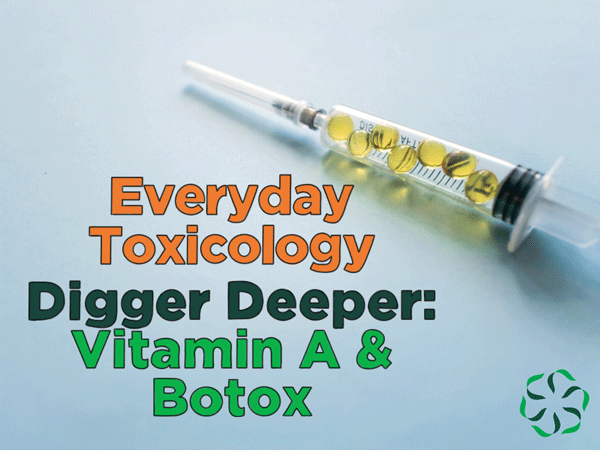Last week, we discussed how a dose of the correct medication can help someone and how improper dosage can cause harm. In this post, we’ll take a more in-depth look at some of the examples we encounter.
We covered primary and secondary effects of medications in our last post. As our understanding of science and toxicology advances, so does our knowledge on how to harness the primary and secondary effects of compounds, even ones considered dangerous.
In this post, we’re going to explore vitamin A to show that the same chemical can exert different effects at different doses and how it can impact health depending on the dosage. We will also explore how a compound, botulinum toxin, considered to be a poison, can, at the right dose, be a cure.
Let’s talk about vitamin A.
Vitamin A is a crucial nutrient needed to develop our eyesight and immune system and is critical to reproductive health. A lack of vitamin A, known as a deficiency, in childhood leads to blindness and can diminish the ability to fight infection.
You can get the recommended doses of vitamin A through a healthy diet that includes vegetables and fruits such as sweet potatoes, spinach, cantaloupe, and more. A healthy diet can provide you with the correct doses of many vitamins and nutrients, not just vitamin A.
While optimal bodily function is the primary effect of vitamin A, there are many secondary effects of vitamin A and vitamin A derivatives that researchers discovered can help with specific skin ailments. However, to get the secondary effects, it needs to be concentrated into a more potent form so it can be taken at a high enough dosage.
You may be familiar with vitamin A derived lotions called retinol lotions that are used to treat acne. Retinol lotions can be over-the-counter or prescription depending on the intensity of the active vitamin A derived ingredients. This means retinol lotions provide a higher dosage of vitamin A compounds than you can typically get from food. These higher doses of vitamin A derivative have a therapeutic effect on acne.
However, the positive effects do not come without, sometimes, undesired effects. In the case of retinol lotion, people will experience dry skin, sun sensitivity, redness, irritation, and more as the dosage and dose-rate increases.
Treating acne and skin ailments through retinol lotions may still not provide a powerful enough dose. In that case, medical doctors can prescribe a more potent dose of vitamin A derivative in a pill medication.
While this higher dose and dose-rate will increase the desired attributes and can help treat severe skin conditions, it can also increase the severity of the undesired side-effects and can include new secondary effects such as nausea, headaches, baldness, liver toxicity, and even death.
Medical professionals carefully monitor patients and prescribe doses and dose-rate to ensure the therapeutic results outweigh the adverse effects.
Let’s take a look at Botulinum Toxin.
We see commercials and regularly hear about Botox in our media. As you may know, the active ingredient in Botox is botulinum toxin type A. There are numerous types of botulinum toxin, but type A and B are most commonly used for cosmetic and medical treatments.
There is a reason botulinum is referred to as a toxin; it’s because it causes nerve damage, including paralysis, and at a relatively low dose can lead to death. For example, the lethal dose of injected botulinum toxin is 0.12 mg, if we compare that to something familiar, like salt, it’s like saying 1/48,000 tsp of salt could cause death!
Yet, such a lethal toxin is safely used in cosmetic and medical treatments routinely because medical experts have calculated the safe dosage.
Experts want to use the primary effect of botulinum toxin, which is temporary paralysis but do not want to cause irreversible damage. The temporary paralysis can be quite useful in treating spasticity and muscle spasms that cause severe pain.
Experts can use safe doses of the botulinum toxin at proper dose-rates to have the desired paralysis effect. A safe dosage can be roughly 200 units of Botox, which would be 100-fold LESS than the lethal dose. Experts would also administer the toxin at a dose-rate of every 3-4 months to ensure efficacy and safety.
We can see from these examples, how researchers and medical professionals harness doses, dose-rates, and primary and secondary effects to treat many different ailments. We can also see that something that can be essential to our health, such as vitamin A, can also be harmful if taken at a potent dose. Meanwhile, something that is a potent poison, botulinum toxin, can be used safely at the correct dose.
As we’ve learned, the dose truly makes the poison and the cure.

